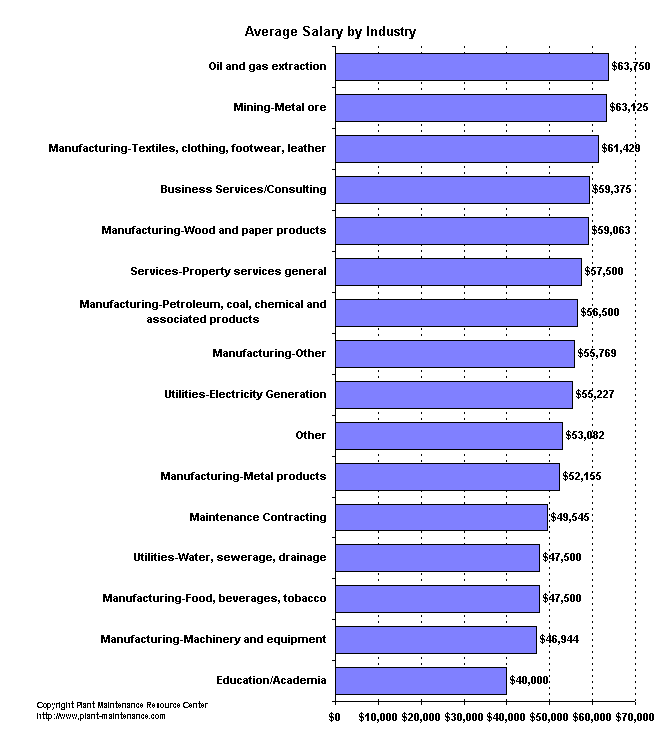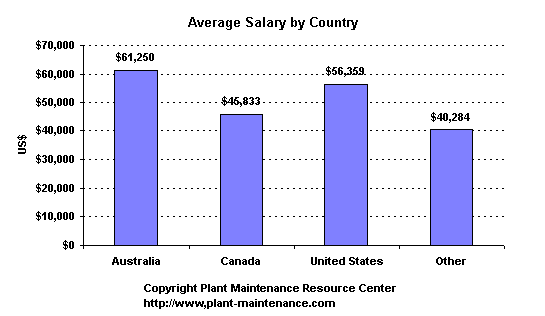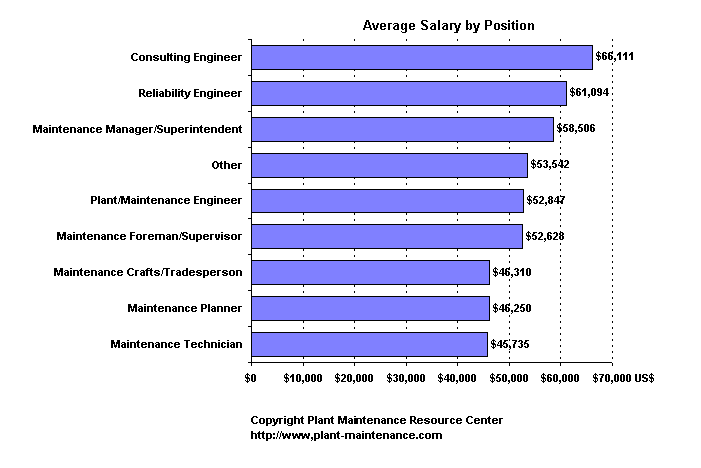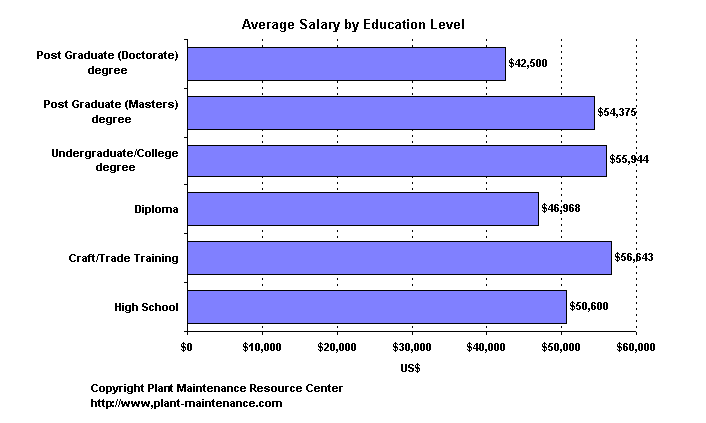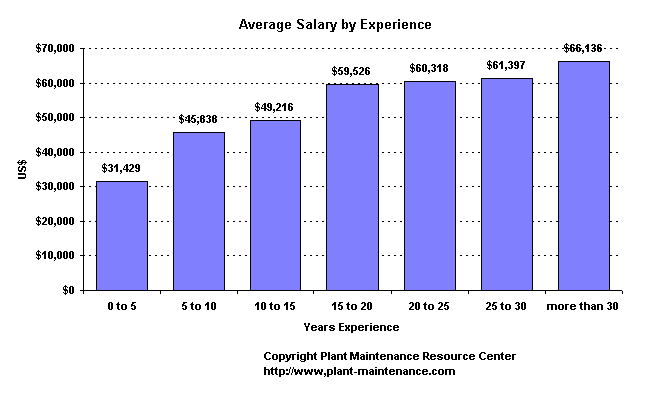|
| Plant Maintenance Resource Center
1999 Maintenance Salary Survey Results
| |
|
|
|
|
|
1999 Maintenance Salary Survey ResultsOverviewThe inaugural survey of salaries in the Maintenance sector was conducted on the Plant Maintenance Resource Center website between January and March 1999. The survey has highlighted a few interesting findings, most notable of which is poor correlation between higher levels of education and increased salary. In other words, a college or university education does not appear to lead to higher pay.This salary survey is a regular, annual event. The 2000 Maintenance Salary Survey was conducted from January to March 2000, and the results are available here. If you would like to be notified via e-mail when the 2001 Maintenance Salary survey opens, please send an e-mail to salary-survey2001@plant-maintenance.com. Raw Data - OverviewVoluntary (and confidential) responses were sought to the survey, and 290 valid responses were received from a wide range of individuals.Raw Data - IndustriesThe greatest number of responses were from individuals in the Manufacturing industries, or Maintenance Contracting industry. A complete list of industries represented is tabulated below.
Raw Data - CountriesOver 70% of the responses received were from the USA, followed by Canada and Australia as the countries with the next greatest number of responses.
Raw Data - Job PositionsThe positions with the greatest representation in the survey were Maintenance Managers/Superintendents, followed by Maintenance Foremen/Supervisors and Plant/Maintenance Engineers.
Raw Data - Educational LevelsEducational levels represented were fairly widespread.
Raw Data - Work ExperienceA wide range of work experience was represented, as well.
Raw Data - SalariesThe total (pre-tax) salaries, inclusive of all benefits, displayed a double-peaked normal distribution.
Overall ResultsThe median salary band was US$50,001-$55,000. Assuming the average salary for each band is the midpoint of each band, the mean salary is US$53,521.Salary by IndustryAn analysis of salaries by industry indicated that the industries paying the highest salaries were Oil & Gas extraction, and Mining. To the surprise of few, perhaps, Education and Academia had the lowest overall salaries.Note that, for the purpose of this analysis, only industries containing 10 or more respondents were included. The overall result is shown graphically below.
Salaries by CountryOnce again, only countries with 10 or more respondents were included in this analysis, which showed that the highest salaries were to be obtained in Australia, followed by the US and Canada. The difference in salaries between Canada and the USA is very marked - the US appears to pay over 20% more. All of these three countries had higher average salaries than the average for all other countries. Of course, it should be noted that tax rates will differ between countries, as will the cost of living, so direct comparisons of salaries between countries should be treated cautiously.
Salaries by PositionYet again, only positions with more than 10 respondents were included in this analysis. This indicated that the highest paying positions were Consulting Engineer, and Reliability Engineer, who were both paid more than Maintenance Managers/Superintendents. Note the large (15%) difference in salary between Reliability Engineers and Plant/Maintenance Engineers. It is also interesting to note that, on average, Maintenance Planners are paid 12% less than Maintenance Foremen/Supervisors, and earn almost the same as Maintenance Crafts/Tradespeople - although this may also reflect the fact that Foremen/Supervisors and Crafts/Tradespeople often are required to work shift work and/or at weekends (with an appropriate pay premium), whereas Maintenance Planners generally work regular Monday to Friday day hours.
Salary by EducationThis resulted in the greatest surprise of the survey. As illustrated in the graph below, it would appear that, after having completed craft/trade training, there is no financial benefit in continuing on to complete a College or University education. In fact, completing post-graduate education leads to even greater drops in salary.
Salary by ExperienceThere is no replacement for experience in generating additional salary, if this survey is any indication. Increases in salary are most marked in the early years, but continue until retirement.
Future enhancementsIn the survey, opportunity was given to respondents to comment on the survey, and many valuable suggestions were made. As the survey was, for obvious reasons, confidential, we were unable to respond directly to those making the comments, but take this opportunity to respond to the comments that were made. Salaries by StateA few respondents suggested that performing a salary survey by state would be appreciated. Given the high number of responses gained from the US, the next survey will include further analysis by state (within the US).Multiple choice optionsSome respondents felt it difficult to make a single choice from the options available (particularly in terms of job role, and industry). This will always be a restriction in this type of survey, but in future surveys we will make it clear that respondents should select their primary job role or industry.Missing industriesIt became apparent that the Healthcare industry was a significant omission from the list of industries available in the survey. This will be added to all future industries. Some clarification of the industry titles will also be made to make it easier for respondents to select the appropriate industry.Education levelsAssociate degrees will be added to the list of education levels available.A few other comments were made regarding the Plant Maintenance Resource Center site in general, for which we offer thanks, and will endeavour to cover the topics requested, as time permits. ConclusionIn summary, the main conclusions from this survey are:
Throughout the year, the Plant Maintenance Resource Center runs a series of surveys on topics of interest to Maintenance professionals. To access the latest survey, visit here. Ó
Plant Maintenance Resource Center 1999
If you wish to copy or distribute this article, please email me to ask for permission first!
Copyright 1996-2009, The Plant Maintenance Resource Center . All Rights Reserved.
|

